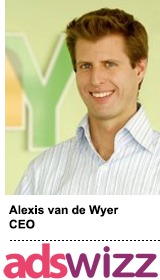 AdsWizz has a hand in all things programmatic audio.
AdsWizz has a hand in all things programmatic audio.
The company started out in 2010 as an ad server for the digital streams from Cox, iHeartMedia, Spotify and TuneIn Radio.
As programmatic audio inventory grew, AdsWizz launched AdWave, a marketplace with more than 2 billion monthly impressions from 39 markets. AdWave hooks into major demand-side platforms (DSPs) like MediaMath, AppNexus and The Trade Desk as well as agency trading desks.
Soon after, AdsWizz launched a supply-side platform (SSP) to help audio companies dabbling in programmatic manage their local sales efforts.
When holding companies like Havas and Omnicom requested specialized audio functionalities that standard DSPs didn’t support, AdsWizz launched a buying platform with lean-back ad units that can activate while the user is listening to music but not engaging with the screen, such as shaking the phone to trigger an ad.
“There [was] no real tool to buy digital audio,” said AdsWizz CEO Alexis van de Wyer. “You don’t have singularity of inventory focus, interactive formats or data and metrics.”
Earlier this year, in partnership with National Public Media, AdsWizz created PodWave, the first programmatic exchange for podcast inventory. Podwave has “hundreds of millions of impressions” from networks including WNYC and NPR, van de Wyer said.
“Just in the last few months, the volume and number of partners has exploded,” he said.
He spoke with AdExchanger.
AdExchanger: Why has programmatic audio been slower to develop than other channels?
ALEXIS VAN DE WYER: There was no supply. Now you have TuneIn, iHeart and Spotify available programmatically. You have supply with the exception of Pandora.
There was demand. I remember Kayak, a big audio buyer, said, “I can’t wait until we do the stuff we’re currently doing programmatically.” In Q4, a lot of big advertisers and holding groups ran campaigns, so I expect this year, you’ll see more going programmatic.
Why has Pandora been late on programmatic audio?
They have much more to lose, so they’re being careful. They let other people try first, and then they’ll get involved.
Is programmatic making digital audio more attractive to advertisers?
Mostly, it opens up new buyers. Radio buyers were already buying. Now you see the extension to digital media and mobile buyers. They see audio as a way to effectively monetize apps that run in the background. If you can’t see the screen, video won’t be effective, but audio can be.
Advertisers worry that programmatic will ruin the authenticity of host-read podcast ads. Do you think programmatic has a place in podcasting?
Sponsorship makes a lot of sense, but if you want to scale, it’s almost impossible. You need programmatic to extend your reach. Programmatic is just automation. It doesn’t mean you can’t have fine targeting and make sure ads match your audience and content. You can limit to a specific group, number of buyers or a few vetted advertisers in private deals. For me, there’s no doubt that more will be automated.
What measurement challenges still exist for podcasts, given that Apple doesn’t share data?
We have an SDK for all of our podcast players that measures when a podcast has been listened to offline to see if the ad has been played. Most of our podcast partners provide data. It’s in their interest because they sell directly and they want to use the data from our ad server.
We’re trying to work more closely with Apple. They’re being pretty receptive, there are some conversations going on. I don’t know where those conversations will land, but they’re open to discussing it.
Do publishers generally use AdsWizz’s whole suite of products?
They can use whatever fits their strategy. iHeartMedia uses everything from A to Z. Spotify uses our SSP, DSP and marketplace, but not our ad server.
Our SSP and DSP have been growing fastest because they are new, and programmatic is picking up speed with much more significant buys. The game definitely has changed.
How is working with a broadcaster different than a pure play digital audio company?
It’s how and where you insert the ads. Our technology detects when and how many ads should be inserted. You can define that in many different ways [based on] how many seconds of ads can be inserted [in the stream].
What’s unique about your exchange compared to the others, like Triton’s a2x?
The size. We have 2 billion impressions. We have publishers that don’t exist on Triton’s marketplace, like iHeartMedia. You can find more traditional broadcasters on a2x and more pure play and new services on our exchange.
What are your targeting capabilities?
There’s user-level data and behavioral data, like what the listener is doing, what kind of device he is using and [whether] he is moving. A lot of publishers have age, gender and registration information. We integrate with Exelate, Lomate, Crosswise, LiveRamp, et cetera, to enrich that data and give them more complete pictures of the user.
How granular can you get?
Every insertion is personalized. Some advertisers can have 2,000 versions of the same ad with different messages depending on the user profile, location, et cetera. Others have more generic ads they stream to everyone. Even though the insertion is personalized, the ad is not necessarily.
How do you measure effectiveness?
We measure the listen-through rate, or the number of times people tune away from the stream because of the ad. We also measure return on investment for the advertiser, whether through online performance, online sales or offline sales. Online, for example, we’ll track the number of visits to and actions on a website and link that to the ad.
Do you do offline-to-online attribution?
That’s becoming more important. We partner with agencies, publishers and attribution companies. Most of them are not equipped for audio, so we’ve had to build a lot ourselves.













